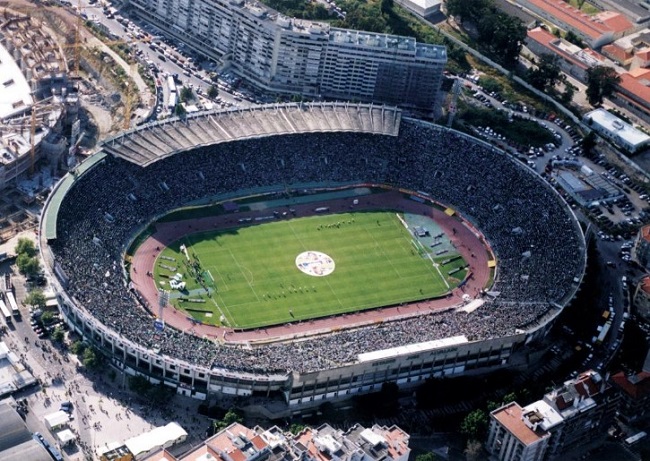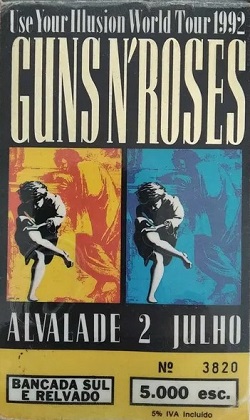
Sporting were always the more well-to-do club of the Big Three. The patronage of the Alvalade Viscount and the social status of many of its early players and board members guaranteed the club would never have a hard time, particularly finding a place to play. While neighbours Benfica travelled all around Lisbon until they finally settled in where they are today, Sporting grew as an institution around the Campo Grande area. It was there, neighbouring their old ground, that in 1956 the José de Alvalade stadium was inaugurated, a landmark site for the history of Portuguese football.
***
A stadium fit for the champions of the day
Now it’s all modern and flashy. The most recent revamped works have made it even more enticing, and no-one can forget its opening day and the golden performance of a young academy graduate in the summer of 2003 who packed his bags for England the following day. The old José de Alvalade, though, was something else. A stadium of its time, a reflection of the Portugal that was, which also somehow represented the club’s multi-sports identity. A ground where both the Lisbon Lions and the national side enjoyed moments of pure ecstasy, and which came to life right at the pinnacle of Sporting’s undisputed domestic dominance. It was a culmination of three decades where they had been the strongest club in the land.
Although the ground was officially inaugurated on 10 June 1956, Sporting had been playing in the nearby Campo Grande pitch and then in the Estádio do Lumiar, also popularly known as the stadium of Lisbon. As the club’s growth quickly exceeded expectations, talk about the possibility of moving to a bigger-capacity venue had been ongoing since the early 1940s. During the decade, António Salazar’s government began to focus its attention on big construction projects to modernise facilities, expand the main urban areas and give a boost to the impoverished local economy.
Lisbon quickly became a construction site with new highways or iconic buildings replacing the traces of the old and less cosmopolitan capital. The Duarte Pacheco bridge, the bridge that connected the city with Almada and the redevelopment of the local airport, were some of the most high-profile works, but sports were also included in the big picture. The Jamor stadium was inaugurated in 1949, and by that time Sporting had decided they needed to expand from the old Lumiar – which had also been built by José de Alvalade, the club’s founder and whom the club paid homage to with the stadium’s name – to a bigger and better ground.
Monumental initial project shelved
However, the final blueprint was only approved in 1954 from a first concept drawn by Anselmo Fernandez that never came true in its entirety. Fernandez was a famous club supporter and a former sportsman. He refused to be charged for his work and originally proposed a different stadium, with two similar central stands, both covered, placed in front of each other and surrounded by two larger ends, with a racetrack around the grass pitch. It was a monumental project that also included pavilions for the practice of different indoor sports and would have become one of the biggest sports venues in the Iberian Peninsula, only surpassed by the Chamartin stadium of Real Madrid. Sadly, it was also too expensive, with a large east area reserved for the peão, the fans who remained on foot by the sidelines.
Fernandez would later become the club manager who guided Sporting to their only European win, the Cup Winners Cup in 1964, thus making him one of the most important personalities in the club’s history, the only European trophy winner, who also projected his club’s stadium. Sporting hired the Alves Ribeiro company, supported by the expertise of Ruy José Gomes, and a working staff of more than 1400 people, a huge investment at the time that allowed the club to complete the construction in record time. It was financed by a group of well-to-do club members – 43 in total, who collected up to 8 million escudos, the currency at the time – with the backing of the famous Espírito do Santo banking institution, whose family was closely linked to the club since its inception and has been ever since. The first stone was laid at the end of 1954, and the stadium was inaugurated a year and a half later.
During those months, Sporting mostly played at the Jamor, including the first European Cup match in history – a 3-3 draw against Partizan Belgrade – as the new ground also overlapped with the terrain where the old one stood. Famously, club members paid a small fee to pick up pickaxes to tear down the old stands to make way for the new. Crucially, the project also included the first floodlight facilities that would make late kick-offs extremely popular during the following years.

As with every major social event, the inauguration date for the new ground was established by Salazar’s regime. On 10 June, the so-called Race Day – now the Day of Portugal, Camões and the Portuguese Communities – at the end of the 1955/56 season held one of the biggest parties Lisbon had ever seen. It began early in the morning with crowds flocking to the ground, waiting their turn to get in. More than 60,000 participants were involved in the event that began with folkloric dances, tributes to more than 1500 club athletes and representatives of more than 200 sporting clubs from all over the nation who travelled to pay their tribute to the Lions’ new home.
The stadium included a large cycling track (later replaced by a tartan one in the late 1970s) that sat supporters far from the pitch but allowed the club to host several sporting events. A group of Vespa motorcycles ended the event by circling the cycling track to thunderous applause. After the usual political speeches, customary in those days, Sporting’s first team faced the prestigious Vasco da Gama, considered one of South America’s top clubs and one deeply rooted within the Portuguese community established in Rio de Janeiro. The Brazilians won 3-2, and Juca, later club manager, scored the first goal, even if it was an unfortunate own goal. From the famous Five Violins line-up, only Vasques played in the starting eleven. José Travassos was injured at the time but was seen earlier carrying the club’s banner, and players from other clubs took part as well, like Fernando Cabrita, who would guide Portugal to the Euro 84 semi-finals almost thirty years later.
Concert venue
 At the end of the following season, Sporting were crowned league champions, the first trophy collected by the club in their new stadium. They would celebrate ten more over the following forty-eight years, including the 2002 win, which turned out to be the last, largely due to Mário Jardel’s and João Vieira Pinto’s goals. Iconic players such as Cristiano Ronaldo, Ricardo Quaresma, Luís Figo, Paulo Futre, Manuel Fernandes, Rui Jordão and Hilário played at a ground that soon became an everlasting part of the national sporting folklore, hosting several stages of the Volta à Portugal cycle race, and national and international athletics events.
At the end of the following season, Sporting were crowned league champions, the first trophy collected by the club in their new stadium. They would celebrate ten more over the following forty-eight years, including the 2002 win, which turned out to be the last, largely due to Mário Jardel’s and João Vieira Pinto’s goals. Iconic players such as Cristiano Ronaldo, Ricardo Quaresma, Luís Figo, Paulo Futre, Manuel Fernandes, Rui Jordão and Hilário played at a ground that soon became an everlasting part of the national sporting folklore, hosting several stages of the Volta à Portugal cycle race, and national and international athletics events.
The ground also became famous for its music concerts, particularly from the 1980s onwards. The likes of the Rolling Stones, Pink Floyd, David Bowie, The Cure, Dire Straits, Michael Jackson, U2 and Guns N’ Roses performed at the Alvalade when they visited Lisbon and the biggest crowd for a national gig was recorded there, when GNR came to town to record a live album that became one of the most sold albums in Portuguese music history. By then João Rocha had already built the east end, not as Fernandez had hoped for – with a roof – but of a slightly bigger capacity, thus taking the maximum attendance to almost 80,000, a number that was reduced when UEFA made mandatory all-seating stadiums. The new stand also hosted the pavilion where the side’s famous roller hockey, basketball and handball sides would perform wonders.
However, there were tragic moments as well. In the mid-1990s it became clear the ground was not up to quality standards as it had been, and during a visit from Bobby Robson’s FC Porto for a title decider, as a group of supporters decided to assault the Dragons staff and players from a balcony, the structure failed, and two supporters died while dozens ended up injured. It was a sign that the Alvalade needed more than just a new lick of paint. As Portugal was awarded the hosting of the 2004 European Championship, the club believed that, more than just improving the existing facilities, they should demolish the old ground and build an entirely new one.
The 2002/03 season became the last campaign played at the old José de Alvalade. Sporting started the season as league champions but were unable to rival José Mourinho’s FC Porto, who won the last Clássico at the old stadium with a Costinha goal. During the season, part of the construction works of the new ground made it mandatory to tear the south end down, as the stadium would be built only a few metres away. Sadly, the last official match attended at the ground ended with a 4-3 defeat against Vitória SC, curiously a club that sported the same white and black colours as Vasco da Gama, who had won the first match played there.

Portugal also played several internationals at the old Alvalade, most famously a 6-0 win against Cyprus that helped qualify the national side to the 2002 World Cup and decisive wins against Austria and Slovakia that paved the way for the Golden Generation to book a ticket for Euro 1996 and Euro 2000 after ten years of absence from a major tournament.
The new Alvalade XXI has since become one of the most state-of-the-art football grounds in Europe, venue of a UEFA Cup final, where cruelly Sporting would be beaten by Russian outfit CSKA, and a Women’s Champions League final, besides several matches during Euro 2004, including two key wins for the home side, against Spain in the group stage and The Netherlands in the semi-finals.

But for many who enjoyed Sporting’s golden years, there’s something about the old Alvalade stadium that will never be replicated. The memory of a time when the green and white hoopers were regarded as the strongest club in the land, and where football, music, cycling, athletics, and cultural events went hand in hand in a venue like no other.
By Miguel Lourenço Pereria, author of “Bring Me That Horizon – A Journey to the Soul of Portuguese Football”.

